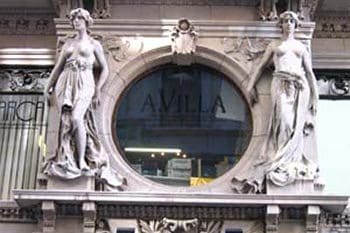
Discovering Caravaggio: the Most Famous Painter in Italy
By Oscar Davis
Caravaggio, one of the most influential artists of all time, revolutionized the art world with his dramatic use of light and shadow, intense realism, and emotionally charged subjects. His techniques and powerful compositions have left an indelible mark on the history of art, inspiring countless artists and captivating audiences for centuries.
Caravaggio’s masterpieces are displayed in some of Italy’s most beautiful and prestigious museums, offering a unique opportunity to experience his genius first-hand. In this article, we will explore the most important works of Caravaggio, delving into their significance and where you can admire these stunning paintings in Italy.

Pinacoteca Ambrosiana: La Canestra di Frutta
The Pinacoteca Ambrosiana in Milan is one of Italy’s most renowned art galleries, housing an impressive collection of works spanning various periods and styles. Among its treasures is La Canestra di Frutta (The Basket of Fruit), a remarkable painting by Caravaggio created between 1597 and 1600. This work is considered one of the earliest and finest examples of still life in Western art, displaying Caravaggio’s extraordinary skill and innovative approach.
La Canestra di Frutta is a seemingly simple yet profoundly intricate depiction of a basket overflowing with fruit. However, Caravaggio’s genius lies in his ability to imbue this still life with an astonishing sense of realism and symbolic depth.
The fruits, depicted with meticulous detail, appear almost palpable, with their imperfections, decay, and varying stages of ripeness contributing to the lifelike quality of the painting. This realism is so striking that the fruit seems paradoxically alive, capturing the transient beauty of nature.
Beyond its realistic portrayal, La Canestra di Frutta is rich in symbolism. The decaying leaves and blemishes on the fruit can be interpreted as a memento mori, a reminder of the inevitable passage of time and the transient nature of life. This painting, with its blend of beauty and decay, invites viewers to contemplate the delicate balance between life and death, a recurring theme in Caravaggio’s work.
The Pinacoteca Ambrosiana provides a fitting home for this masterpiece, allowing visitors to appreciate the depth and complexity of Caravaggio’s vision. The gallery itself is a cultural and historical gem, offering a serene and contemplative environment in which to explore some of the most significant works of art from the Renaissance and beyond.
Uffizi Gallery: 3 Must-See Works by Caravaggio
The Uffizi Gallery in Florence is one of the most prestigious and renowned art museums in the world, boasting an extraordinary collection of Renaissance masterpieces. Among the treasures housed within its historic walls are three remarkable works by Caravaggio, each displaying different facets of his revolutionary approach to art.
Il Bacco (1597)
One of Caravaggio’s most captivating paintings at the Uffizi is Il Bacco (Bacchus), created in 1597. This painting presents the Roman god of wine and revelry as an adolescent, reclining with a goblet of wine and a garland of grapes and leaves. Caravaggio’s Bacchus is depicted with a striking realism that reveals the artist’s exceptional skill in capturing human flesh and textures.
The adolescent god’s flushed cheeks, slightly inebriated expression, and the meticulously detailed still life of fruit and wine create a vivid, almost tangible image. The painting subtly conveys themes of indulgence and mortality, reflective of Caravaggio’s masterful use of chiaroscuro and naturalism.
Scudo con Testa di Medusa (1598)
Another masterpiece by Caravaggio at the Uffizi is the Scudo con Testa di Medusa (Medusa), completed in 1598. This work was commissioned by the powerful Medici family and is a stunning example of Caravaggio’s dramatic and intense style. The painting, rendered on a convex wooden shield, depicts the severed head of Medusa at the moment of her decapitation by Perseus.
Caravaggio captures the horror and agony in Medusa’s face with extraordinary realism, her snake-like hair writhing violently. The use of the shield as a canvas adds a unique dimension to the artwork, enhancing the illusion of Medusa’s head emerging towards the viewer, embodying the artist’s innovative approach to composition and perspective.
Il Sacrificio di Isacco (1603)
The third significant Caravaggio painting at the Uffizi is the 1603 version of Il Sacrificio di Isacco (The Sacrifice of Isaac). This powerful biblical scene portrays the dramatic moment when Abraham, commanded by God, is about to sacrifice his son Isaac.
Caravaggio’s mastery of light and shadow heightens the emotional intensity of the scene. The anguished expression of Isaac, the resolute yet sorrowful face of Abraham, and the sudden intervention of the angel create a poignant tableau of faith, obedience, and divine intervention.
The realism with which Caravaggio renders the figures and the psychological depth of their expressions make this painting a profound meditation on trust and sacrifice.
The Uffizi Gallery, with its vast and unparalleled collection, provides an ideal setting to appreciate these masterpieces by Caravaggio. Each painting offers a unique insight into the artist’s innovative techniques and profound storytelling abilities, visiting the Uffizi an essential experience for any art lover.
Museo Nazionale di Capodimonte: Flagellazione di Cristo
The Museo Nazionale di Capodimonte in Naples is one of Italy’s premier art museums, housing an extensive collection of masterpieces that span several centuries. Among its notable works is Flagellazione di Cristo (The Flagellation of Christ), painted by Caravaggio in 1608. This painting is one of the two remaining works in Naples from Caravaggio’s first Neapolitan period, marking a significant phase in the artist’s tumultuous life and career.
Flagellazione di Cristo is a powerful depiction of the brutal moment when Christ is scourged before his crucifixion. Caravaggio’s intense realism and dramatic use of light and shadow are vividly evident in this work. The composition centers on the figure of Christ, who stands bound and tormented by his captors. His face is serene yet sorrowful, capturing a profound sense of suffering and resignation.
The painting’s stark contrasts between light and dark, a hallmark of Caravaggio’s style, draw attention to the physical and emotional agony of the scene. The play of light illuminates Christ’s body, emphasizing his vulnerability and the brutal force of his assailants. Each figure is rendered with meticulous detail, from the tense muscles of the tormentors to the contorted expressions of cruelty and pain.
Flagellazione di Cristo also carries deep symbolic and theological meanings. It reflects themes of sacrifice, redemption, and human cruelty, inviting viewers to contemplate the spiritual and existential dimensions of Christ’s suffering. Caravaggio’s ability to convey such profound emotion and narrative through his innovative techniques solidifies his place as a master of Baroque art.
The Museo Nazionale di Capodimonte provides an ideal setting to appreciate this masterpiece. Housed in the former Bourbon palace, the museum’s grand halls and exquisite galleries offer a serene and contemplative environment for viewing Caravaggio’s work. The Flagellation of Christ stands as a testament to Caravaggio’s genius, capturing the intense drama and raw emotion that define his artistic legacy.
Visiting the Museo Nazionale di Capodimonte to see the Flagellation of Christ allows one to delve into the rich cultural and artistic heritage of Naples, experiencing firsthand the profound impact of Caravaggio’s revolutionary vision.

Galleria Borghese and Caravaggio
From Naples, it is possible to continue the journey to discover Caravaggio’s works also in Rome, in particular by going to the Galleria Borghese. To reach the capital, you can opt for the train. Italo quickly connects the cities of Naples and Rome, making it easy for visitors to travel between these two iconic destinations. With high-speed trains, you can travel from Naples to Rome in just over an hour.
The Galleria Borghese in Rome is a magnificent art gallery located in the heart of the Borghese Gardens. It is renowned for its impressive collection of Renaissance and Baroque art, including several masterpieces by Caravaggio.
Among the notable works by Caravaggio housed in the Galleria Borghese are Bacchino malato, Fanciullo con canestro di frutta, and San Girolamo scrivente. These paintings highlight different aspects of Caravaggio’s revolutionary approach to art, from his realistic portrayal of human figures to his dramatic use of light and shadow.
Bacchino Malato (1593-1594)
Bacchino malato (Sick Bacchus) is one of Caravaggio’s early works, painted around 1593-1594. This self-portrait depicts the artist as Bacchus, the Roman god of wine, looking pale and ill.
The painting is characterized by its lifelike representation and the naturalism for which Caravaggio became famous. The delicate rendering of Bacchus’s sallow skin and the detailed still life of fruits in the foreground displays Caravaggio’s exceptional observational skills and his ability to convey human vulnerability and fragility.
Fanciullo con canestro di frutta (1593-1594)
Fanciullo con canestro di frutta (Boy with a Basket of Fruit) is another early work, painted around the same time as Bacchino malato. This painting features a young boy holding a basket brimming with a variety of fruits.
The boy’s youthful innocence and the lush, detailed depiction of the fruits demonstrate Caravaggio’s mastery of both portraiture and still life. The rich textures and vibrant colors create a strikingly realistic image, reflecting the artist’s innovative use of chiaroscuro to enhance depth and dimension.
San Girolamo scrivente (1605-1606)
San Girolamo scrivente (Saint Jerome Writing) is a powerful depiction of Saint Jerome, the scholar and translator of the Bible. Painted between 1605 and 1606, this work displays Caravaggio’s ability to capture intense emotion and intellectual depth. The saint is shown deep in contemplation, his furrowed brow and focused gaze reflecting his scholarly dedication. The dramatic lighting highlights the aged, muscular form of Jerome, emphasizing the physical toll of his devotions. The vivid realism and psychological insight make this painting a profound meditation on faith and intellect.
The Galleria Borghese provides a stunning setting to appreciate these masterpieces. The gallery’s exquisite architecture and beautifully arranged rooms allow visitors to immerse themselves fully in the art. Each of Caravaggio’s works is displayed to highlight its unique qualities, making the viewing experience both intimate and impactful.
Museo Regionale di Messina
The Museo Regionale di Messina in Sicily is home to two significant works by Caravaggio, painted during the final years of his life while he resided in the city. These masterpieces, Resurrezione di Lazzaro (Resurrection of Lazarus) and Adorazione dei pastori (Adoration of the Shepherds), showcase Caravaggio’s continued evolution as an artist, reflecting his mastery of dramatic realism and emotional depth.
Resurrezione di Lazzaro (1609)
Resurrezione di Lazzaro is one of Caravaggio’s late works, created around 1609. This powerful painting depicts the miraculous moment when Jesus raises Lazarus from the dead. Caravaggio’s use of light and shadow is particularly striking here, emphasizing the contrast between the lifeless body of Lazarus and the divine presence of Christ.
The dramatic chiaroscuro not only highlights the physical details of the figures but also intensifies the emotional impact of the scene. The expressions of awe, disbelief, and reverence on the faces of the onlookers add to the narrative’s complexity, making this painting a profound meditation on faith and resurrection.
Adorazione dei pastori (1609)
Adorazione dei pastori, also painted in 1609, captures the humble and intimate scene of the shepherds adoring the newborn Jesus. Caravaggio’s depiction of the nativity is characterized by its realistic and accessible portrayal of the holy family.
The somber, earthy tones and the stark lighting draw attention to the tender interactions between the figures. The humble shepherds, with their weathered faces and simple clothing, are rendered with a humanity that bridges the gap between the divine and the everyday. This painting reflects Caravaggio’s ability to infuse biblical scenes with a relatable, human element, making the sacred moments accessible to all viewers.
The Museo Regionale di Messina offers a unique opportunity to view these exceptional works in a setting that preserves the historical and cultural context of Caravaggio’s time in Sicily. The museum itself is dedicated to displaying the rich artistic heritage of the region, providing a deeper understanding of the local influences on Caravaggio’s work during his Sicilian period.
These paintings are invaluable for understanding the final phase of Caravaggio’s career, where his art reached new heights of emotional expression and technical mastery.
The Museo Regionale di Messina, with its focus on regional art and history, is the perfect place to appreciate these masterpieces, offering insights into both the artist’s journey and the broader cultural landscape of 17th-century Sicily.

Oscar Davis is a freelance writer from Leeds, UK.
- Chicago: The Perfect Weekend Jaunt - August 17, 2024
- Quebec’s Eastern Townships and Magog - August 3, 2024
- Exploring California’s Empty Central Coast - April 24, 2024





